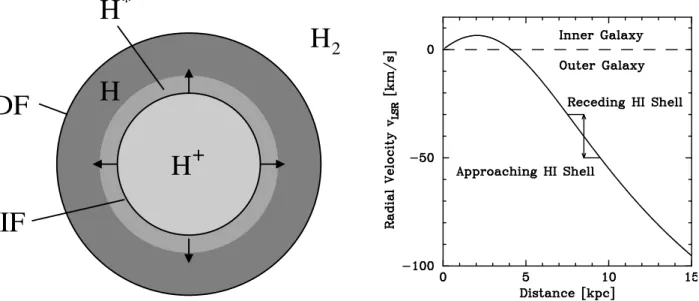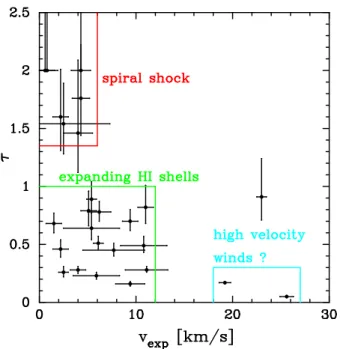Publisher’s version / Version de l'éditeur:
Vous avez des questions? Nous pouvons vous aider. Pour communiquer directement avec un auteur, consultez la première page de la revue dans laquelle son article a été publié afin de trouver ses coordonnées. Si vous n’arrivez pas à les repérer, communiquez avec nous à PublicationsArchive-ArchivesPublications@nrc-cnrc.gc.ca.
Questions? Contact the NRC Publications Archive team at
PublicationsArchive-ArchivesPublications@nrc-cnrc.gc.ca. If you wish to email the authors directly, please see the first page of the publication for their contact information.
https://publications-cnrc.canada.ca/fra/droits
L’accès à ce site Web et l’utilisation de son contenu sont assujettis aux conditions présentées dans le site LISEZ CES CONDITIONS ATTENTIVEMENT AVANT D’UTILISER CE SITE WEB.
Revista Mexicana de Astronomia y Astrofisica (Serie de Conferencias), 15, pp.
163-165, 2003-01-01
READ THESE TERMS AND CONDITIONS CAREFULLY BEFORE USING THIS WEBSITE. https://nrc-publications.canada.ca/eng/copyright
NRC Publications Archive Record / Notice des Archives des publications du CNRC :
https://nrc-publications.canada.ca/eng/view/object/?id=c0572839-2d7d-4dac-8d68-57078e383f0d
https://publications-cnrc.canada.ca/fra/voir/objet/?id=c0572839-2d7d-4dac-8d68-57078e383f0d
NRC Publications Archive
Archives des publications du CNRC
This publication could be one of several versions: author’s original, accepted manuscript or the publisher’s version. / La version de cette publication peut être l’une des suivantes : la version prépublication de l’auteur, la version acceptée du manuscrit ou la version de l’éditeur.
Access and use of this website and the material on it are subject to the Terms and Conditions set forth at
Expanding shells of neutral hydrogen around compact H II regions
Winds, Bubbles, & Explosions: A Conference to Honour John Dyson. Pátzcuaro, Michoacán, México, 9-13 September 2002. Editors: S. J. Arthur & W. J. Henney
© Copyright 2003: Instituto de Astronomía, Universidad Nacional Autónoma de México
RevMexAA (Serie de Conferencias), 15, 163–165 (2003)
EXPANDING SHELLS OF NEUTRAL HYDROGEN AROUND COMPACT
H
IIREGIONS
R. Kothes1,2 and C. R. Kerton1
RESUMEN
Mediante una comparaci´on de las velocidades radiales de regiones HII brillantes a radiofrecuencias con sus espectros de absorci´on en HIhemos descubierto c´ascaras de hidr´ogeno neutro en expansi´on alrededor de ellas. Estas c´ascaras se manifiestan por la absorci´on de la emisi´on de radiocontinuo proveniente de las regiones HIIa velocidades que indican distancias mayores que la velocidad radial observada. Creemos que estas c´ascaras son zonas chocadas en las orillas de las regiones ionizadas en expansi´on.
ABSTRACT
By comparing radial velocities of radio-bright compact HII regions with their HIabsorption spectra, we have discovered expanding shells of neutral hydrogen around them. These shells are revealed by absorption of the radio continuum emission from the HII regions at velocities indicating greater distances than the observed radial velocity. We believe that these shells are shock zones at the outer edges of the expanding ionized regions.
Key Words: CIRCUMSTELLAR MATTER — H II REGIONS
1. THE SAMPLE OF COMPACT HII REGIONS In order to investigate absorption profiles of com-pact HII regions we have looked at all unresolved (Θ 10) outer Galaxy (vLSR<0.0 km s−1) sources
within the area of the Canadian Galactic Plane Sur-vey (CGPS; Taylor et al. 2003) (l = 75◦to 145◦ and
b= −3.5◦to +5.5◦) bright enough to be absorbed by
foreground HI (S ≥ 250 mJy). The resulting sam-ple consists of 26 sources. We compared their HI
absorption spectra with their radial velocity deter-mined from either associated molecular material or recombination line measurements. We found that all but three of this sample show at least one additional absorption line at a more negative velocity than the source’s systemic velocity. A flat rotation model for the Galaxy would indicate that these components are located behind the HII regions. Two example profiles are displayed in Figure 1.
2. A SIMPLE MODEL FOR EXPANDING HI
SHELLS
From our results we can conclude that the ab-sorbing HI, which creates the additional absorption line, is located between the HIIregions and us and it is moving towards us relative to other material at its distance. Since almost all of the sources show this
1National Research Council of Canada, Herzberg Institute
of Astrophysics, Dominion Radio Astrophysical Observatory, Penticton, Canada.
2Department of Physics and Astronomy, The University of
Calgary, Calgary, Canada.
additional absorption line we can assume that it is a common phenomenon related to compact HII re-gions. Thus the most likely explanation is a symmet-rically expanding shell of atomic hydrogen around those compact HIIregions.
Models of the photodissociation of molecular clouds surrounding newly formed O and early B type stars (Roger & Dewdney 1992) show that the result-ing HIexists in a layered structure surrounding the star (see Figure 2, left panel). A dissociation front (DF) will first move rapidly through the molecular cloud (H2) forming a broad HI region (H). As the
HIIregion (H+) expands, a layer of shocked HI(H∗)
will form just outside the ionization front (IF). Even-tually, the faster moving IF will catch up with the DF and all of the HI will be found in the shocked layer. The time when the IF and DF merge ranges from ∼ 105to 106years depending upon the spectral
type of the star and the density of the surrounding molecular material.
The dissociated and ionized material created by the DF and IF are not moving and thus cannot be responsible for the additional absorption lines. How-ever, the thin layer of shocked atomic hydrogen is expanding with the IF. To investigate the character-istics of this expanding HI shell we assume a sys-temic velocity of −40 km s−1 for a compact HII
re-gion with an IF expanding at 10 km s−1 (see Fig. 2,
right panel). The receding part of the shell would be shifted to a velocity of −30 km s−1. By
observ-ing the absorption profile of the HIIregion, we would 163
Winds, Bubbles, & Explosions: A Conference to Honour John Dyson. Pátzcuaro, Michoacán, México, 9-13 September 2002. Editors: S. J. Arthur & W. J. Henney
© Copyright 2003: Instituto de Astronomía, Universidad Nacional Autónoma de México
164 KOTHES & KERTON
Fig. 1. Sample absorption profiles (below 0) from our sample of compact HII regions together with the background
emission characteristics (above 0) interpolated for their position. The dashed line indicates the systemic velocity of the
HIIregions. The upwards pointing arrow indicates the additional absorption line and the downwards pointing one the
probable position of the receding shell.
H
+
H
2
H
*
H
IF
DF
1
Fig. 2. Left: A sketch of a compact HIIregion (H+) with an expanding layer of shocked neutral hydrogen (H∗). The
dissociation front (DF) and ionization front (IF) are indicated, as is the layer of the unshocked HI(H). Right: A diagram
of the radial velocity as a function of the distance from the Sun at a longitude of 76◦ for a flat rotation model with
v = 220 km s−1 and R
= 8.5 kpc. Velocity shifts of an expanding shell with vexp= 10 km s−1 for an HIIregion with
a radial velocity of vd= −40 km s−1 are indicated.
find the emission line of the receding part superposed on the foreground absorption structure, where it is difficult to detect. The approaching shell, however, would be shifted to a velocity of −50 km s−1and thus
create an additional absorption line that seems to arise from “behind” the HIIregion.
3. THE NATURE OF THE ADDITIONAL ABSORPTION LINES
The Roger & Dewdney (1992) model gives us con-straints on characteristics of the expanding shell of shocked atomic hydrogen. The maximum expansion velocity of the IF is about 11 km s−1 and the
maxi-Winds, Bubbles, & Explosions: A Conference to Honour John Dyson. Pátzcuaro, Michoacán, México, 9-13 September 2002. Editors: S. J. Arthur & W. J. Henney
© Copyright 2003: Instituto de Astronomía, Universidad Nacional Autónoma de México
HISHELLS AROUND COMPACT HIIREGIONS 165
Fig. 3. Diagram with calulated τ values for all HII
re-gions as a function of the expansion velocity. Three
groups of sources with possible different origin for the additional absorption line are marked.
mum HIcolumn density of the shocked layer is about 1021cm−2, which translates to a maximum optical
depth of τmax= 1.
In Figure 3 we have plotted the optical depth τ of each additional component found in the absorption spectra as a function of its implied expansion ve-locity. Apparently, most of the components satisfy the constraints laid out for the expanding shells of shocked atomic hydrogen, as indicated in the lower left corner. There are also some high-velocity com-ponents, which are most likely high-velocity winds or jets that just happen to be expanding in our di-rection.
There is another group of sources with low vexp
and very high τ . We believe that these absorption features indicate a possible distance ambiguity in the Perseus spiral arm. According to Roberts (1972) the spiral shock causes the radial velocity to drop by 20 to 30 km s−1 at the beginning of the Perseus arm
and slowly rejoins the flat rotation curve after about 1 kpc. This creates a velocity inversion inside the
C. R. Kerton and R. Kothes: Dominion Radio Astrophysical Observatory, P.O. Box 248, Penticton, British Columbia, V2A 6K3, Canada (charles.kerton@nrc.ca, roland.kothes@nrc.ca).
Fig. 4. Diagram of radial velocity as a function of Galac-tic longitude for sources with high calculated τ values.
Perseus arm. Thus inside the arm the distance is in-creasing with inin-creasing radial velocity as opposed to the flat rotation curve. The density in the closer part of the Perseus arm is significantly enhanced by the spiral shock which would explain the high τ values we obtained.
For this interpretation, we would expect a strong dependence of the radial velocity of this absorption line on Galactic longitude caused by the changing viewing angle to the Perseus arm. To examine this dependence we plotted the vLSR at the center of
the absorption lines as a function of Galactic lon-gitude, for the components with high opacities in Figure 4. The velocity dependence of the compo-nent is obvious. There is only one source far away from the others in the upper left corner of the di-agram. For this component the expansion velocity would be 0.8 ± 2.5 km s−1. It is most likely a local
source with a dense foreground cloud.
REFERENCES
Roberts, W. W. 1972, ApJ, 173, 259
Roger, R. S., & Dewdney, P. E. 1992, ApJ, 385, 536 Taylor, A. R., et al. 2003, AJ, submitted

